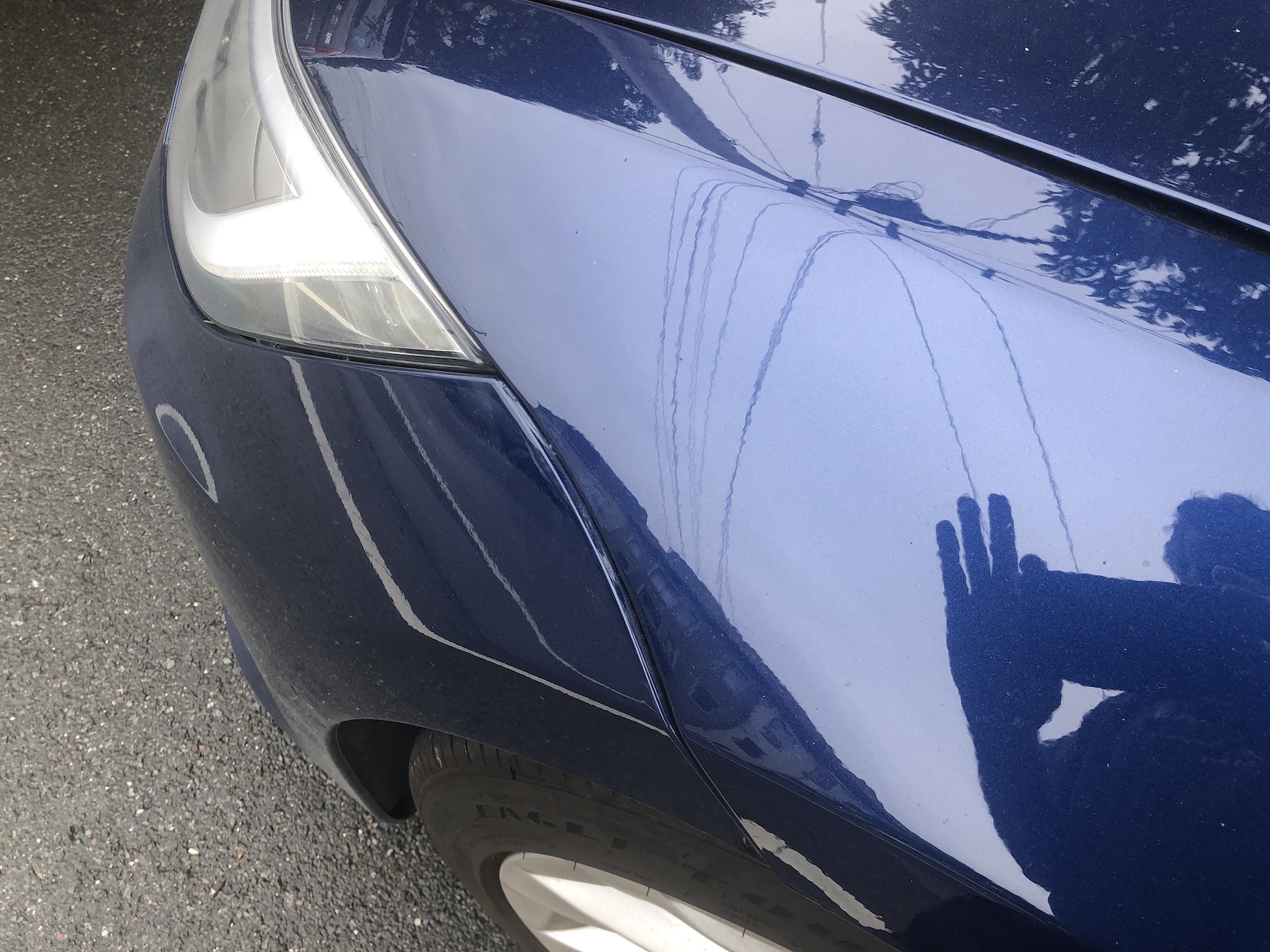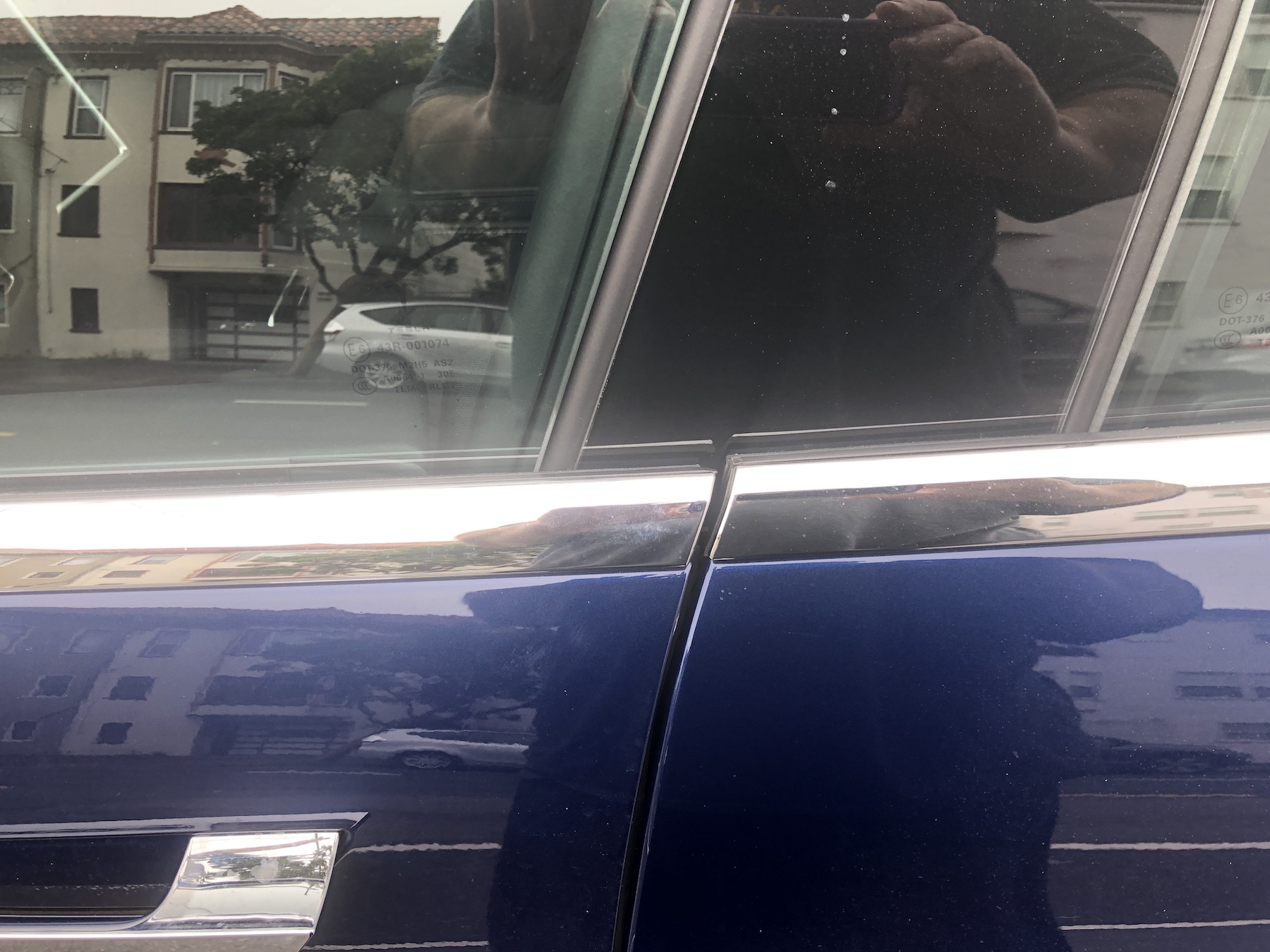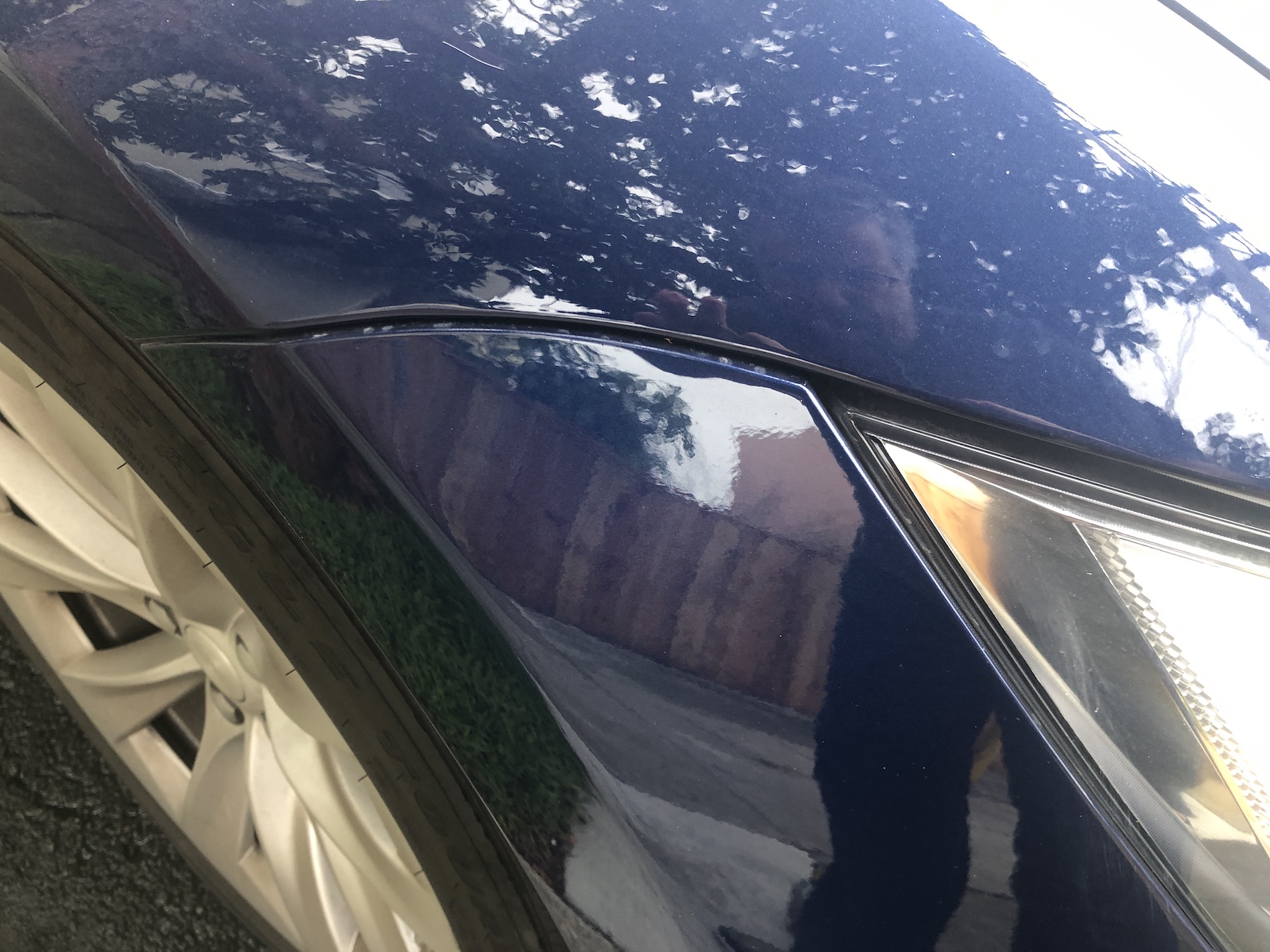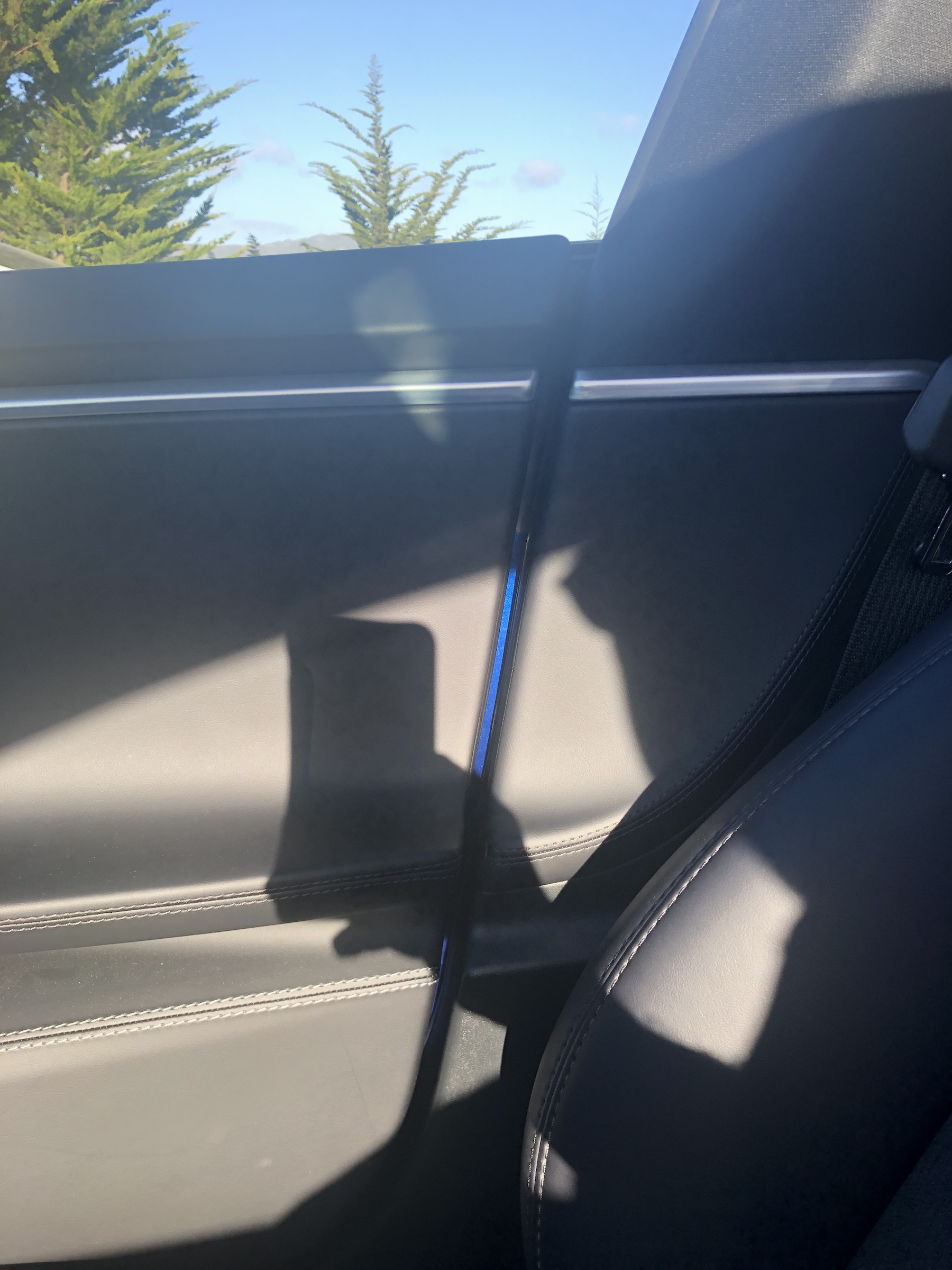Jaguar I-Pace vs. Tesla Model S 75D April 14, 2019
A Comparison of 2019's two leading luxury EVs
I owned a 2018 Tesla Model S 75D from May 2018 through March 2019. I purchased a 2019 Jaguar I-Pace First Edition in March 2019. This post is my thoughts comparing the two.
tl;dr Lease the I-Pace
In all important categories, the first year I-Pace is better than the Tesla Model S, which has been shipping for 6 years.
However, with the velocity of change in the industry, lease, don't buy, an EV. And the I-Pace is the right luxury EV to lease.
Build Quality
If you're going to drive a luxury car, build quality and material quality distinguish cars from the EVs that provide basic transportation.
Spending nearly $100K on a car, one expects a car that's got quality materials and excellent build.
The Tesla radically disappoints here. The Model S has been shipping for 6 years. That's long enough to address build issues. However, my Model S was built very poorly.
Panel Gaps
I used a gap measurement tool to measure the gaps between various panels on both cars.
The Jaguar has uniform 4mm panel gap on all of the car's panels. There are no mis-aligned panels on the Jaguar. And the intersection of the plastic bumpers and the metal body on the Jag is seamless.
The Model S has panel gap variations from 2mm to 9mm. The hood and rear hatch have different gaps on the left and right side.
The Model S front door is not aligned with the rear door:
The front/rear door misalignment issue is common on Model Ss. Just look at a Model S that pulls up next to you. More often than not, the front and rear door height is different.
The bumper on my Model S was not aligned with the body:

And the metal part of the door is visible from inside the car when the doors are closed:
Squeaks and Rattles
The Model S had a ton of squeaks and rattles.
I compare the squeaks and rattles in the Model S with my Ford Fusion Energi (a plug-in hybrid that could do about 20 miles on pure EV) as a base-line for how quiet an EV can be. The Ford had no squeaks or rattles.
I use the Ford as a comparison because the noise of an internal combustion engine often masks small non-engine noises. The Ford provides an apples-to-apples comparison about the noises one can hear while driving as both are EVs.
The Jaguar also has no squeaks or rattles.
Compared to both the Ford and the Jaguar, the Tesla has a ton of noises it should not.
Materials
The Jaguar has much nicer leather, much nicer plastic, and a much more beautiful paint job than the Tesla. I paid more of a premium for the Tesla's blue paint color than I did for the Jaguar's "Santorini Black." Yet, the Jaguar's paint color is much more rich and complex.
The Tesla's flat blue was similar to the Ford's flat black. Serviceable, but not luxury.
In fact, most of the materials in the Tesla were similar in feel to the Ford's materials.
One this that particularly bothered me about the Tesla was that the driver's side floor mat was anchored with velcro. This just never worked. The Jaguar and the Ford both use hooks to anchor the floor mat... it's a small thing that makes a big difference... keeping the mat in place under the driver's feet is important.
Another small thing is that the Jaguar has hanger hooks in the rear... so when I pick up dry cleaning, I can hang it. The Tesla doesn't have this feature. It's a small thing, but points to Jaguar being a car manufacturer that is adding EV and electronics to the car where Tesla is an electronics manufacturer that wraps its electronics in a car... and doesn't really get the "car" part of the equation.
The Touchscreen
The one place that the Tesla shines is the quality and responsiveness of the center touch-screen.
The Tesla's 17" screen was beautiful in all levels of light.
The responsiveness of the Tesla's screen (my car had the new Intel-based system which was more responsive than previous ARM based Tesla screens) was excellent.
Both the software release 8.x and 9.x versions of the UI/UX for car management were done well. Getting to the right place and executing the right command on the Tesla screen was rarely a distraction from the road.
The Jaguar's built-in software is slow, laggy, poorly thought out, and generally sucks.
Using the Jaguar with Apple CarPlay is reasonable. It's not quite as nice and responsive as the Tesla, but it's acceptable.
Peace and Quiet
The Jaguar is a much quieter car. This makes a huge difference when taking conference calls from the car (a major use case for me). Putting aside the Tesla's squeaks and rattles, it's just a noisier car on the highway. This also leads to more driver fatigue in the Tesla.
I had to turn the Tesla's volume up to 10 (out of 11 🙄) to reasonably hear people during conference calls while driving on the highway. A lot of road noise bleeds into calls in the Tesla. It's necessary to mute calls except when speaking.
By comparison, I can hear callers on conference calls at a normal volume level (about 30%). The microphones in the Jag filter road sounds from voice. There's no need to mute in the Jag. The audio for conference calls is very well done.
For both commuting in the Bay Area and road trips, the Jaguar is a better ride than the Tesla.
Driving and Performance
The Tesla and the I-Pace are very closely matched for every-day driving. Both offer a ton of torque, insane acceleration, a smooth ride, and good handling. The only performance difference between the two cars is at the margin.
Soaking up bumps
The Jaguar's suspension is marginally more supple than the Tesla's. Even in "Dynamic" mode (Jaguar's mode for more responsive throttle and harder suspension settings), the Jaguar soaks up potholes and other sub-optimal road conditions marginally better than the Tesla.
Acceleration
The Jaguar only uses the rear motor up to 30mph and then uses both the front and rear motors. This results in a 0.3 second slower 0-60 for the Jag (4.5) vs. the Tesla (4.2).
Seat of the pants, the Jaguar feels slower than the Tesla.
It's much like the difference between my 1990 Mustang GT with a 5.0 liter engine and my 2001 BMW 540i. The 540 felt slower than the Mustang, but that was pure deception. The Mustang and the Tesla are both nasty beasts. The BMW and Jag are velvet covered sledge hammers.
Passing slow drivers on I-5 in both the Jag and the Tesla, one easily nears 100mph without really noticing.
Handling
The Jag has marginally better feedback through the steering wheel and generally telegraphs what's happening with the car better than the Tesla does.
For most of the driving I do, there's no practical difference.
However, the Jaguar set the lap record at Laguna Seca for a stock car. The Jaguar beat every stock Tesla, every stock Porsche, etc. So... if you're looking for a track car, the Jaguar is the best choice.
Conclusion
There's no practical difference between the Jaguar and the Tesla in terms of the kind of driving most of us do. The Jag is marginally smoother and a better platform for conference calls on the road.
Battery Capacity, Driving Experience, and Charging
The Jaguar has a 90kwh battery. The Tesla has a 75kwh battery.
The Jaguar will only let you use 84kwhs of the battery capacity, but there are no restrictions on fully charging the Jag.
The Tesla will allow you to charge to the full, but admonishes you to only charge to 80% for day-to-day use of the car and only use the 100% capacity for road trips.
The EPA range rating for both cars is pretty much the same.
However, the only way I ever got the Telsa to hit its rated power usage was driving at 60mph on a flat part of route 101 with no traffic on a cool day with all electronics turned off, disabling climate control, etc.
The Jaguar operates at or near its EPA rating without any fancy tricks.
Also, the Jaguar's reported energy use and the amount of energy the car takes during charge are very well aligned. The Tesla is radically over-optimistic about how much power it uses and radically over-optimistic about remaining range. Comparing the Tesla in-car numbers with the numbers from TeslaFi.com highlight this gap.
As a practical matter, the Jaguar has a bit more range than the Tesla.
Road Trip Experience
From a charging perspective, the Tesla is currently a better road trip car in California than the Jag. But that is changing.
There are far more Tesla SuperChargers in northern California than there are high speed DC chargers. Also, the SuperChargers have higher output (typically 100kw+) than do most of the DC chargers (typically 26kw to 50kw).
However, Tesla's SuperChargers mean that you're beholden to the Tesla network. To date, the SuperChargers have been a loss center for Tesla. As the company turns into a real business, the fate of the size of the SuperCharger network is vague.
I have taken a couple of road trips with the Jag. I went from San Francisco to lake Tahoe. The charging stops along the way presented a small challenge.
The EvGo DC charger network on I-80 has lots of places to charge. However, there's a bug (as of April 2019) in the EvGo chargers: they will only charge at 40kw. This means 45+ minute stops to charge... and multiple "charge end, go to car, start charge again" cycles. This is because evGo terminates charges at 30 minutes, even if the charge is not complete.
ChargePoint has fewer locations, but 50kw ChargePoint chargers deliver that power to the Jag. Further, ChargePoint will charge the car to capacity rather than stopping every 30 minutes.
I used an Electrify America 150kw charger and it delivered 100kw to the Jaguar... which is currently the maximum that the Jaguar will accept. This experience was aligned with the Tesla SuperCharger experience: the charge-time is about the time to use the restroom and grab a bite to eat.
Net-net: the Tesla has a smaller battery to charge and charges faster than the Jaguar. Once there are more 100kw+ chargers, road-tripping in the Jaguar will on par with the Tesla.
Charging Experience
Tesla has the charging experience nailed down:
- Charging times are easy to set and are geo-fenced. This means that setting "only charge from 11pm to 7am" applies just to my garage. I had to buy a charging station controller to enforce this with the Jaguar. I expect that Jaguar can fix this issue with a software update.
- Not charging to 100%... there's a good reason to keep charge on the Jaguar (and Tesla) under 95%. The single-peddle driving experience needs enough uncharged battery to ensure that energy is regenerated into the battery rather than using the brake. There's no way to tell the Jaguar to charge to 95% rather than 100% overnight. Once again, something that can be fixed in a software update.
- The Tesla gives you a ton more information about charging than does the Jag. The Tesla gives you a real-time readout of volts and amps. The Jag does not. Also, the Tesla can be configured to give the read-outs as percentage rather than the "range" which is almost always wrong for both cars.
I hope that Jaguar does some clinics with existing Tesla owners to understand the value of more data related to charging.
Proprietary
One of the biggest issues from my perspective related to charging and range is Tesla's proprietary approach.
For the Model S, I got a ChaDeMo adaptor so I could use any DC Fast charger. This came to be very useful as we have DC Fast chargers at work. However, the ChaDeMo adaptor was capped at 40kw even though the work chargers deliver 50kw.
The ChaDeMo to Tesla adaptor only works on the Model S and X. It does not work on the Model 3. Thus, with the Model 3, you can only use Tesla's network on a road trip.
With more and more EVs arriving from more and more manufacturers, placing a bet on a proprietary charging network vs. lots of 100kw+ chargers seems like a bad bet.
Day-to-day driving
There are lots of pluses and minuses for each car day-to-day. Here's a partial list.
Size
The Jaguar is shorter and thinner. This means finding parking in San Francisco is easier with the Jaguar. The amount of hauling capacity that the Jaguar gives up is minimal vs. the Model S.
Safety
The Model S has the worst set of driver safety systems I've experienced in a modern car.
The Jag's radar-based blindside monitoring system is accurate and powerful.
The Model S has a sonar-based blindside monitoring system. This means that the Model S will not warn of cars when you're backing out of a parking space. The Jag can differentiate between cars and plants and does not false-positive if you're driving on a boulevard.
The Jaguar has blindside warning lights on the side mirrors... exactly where your eyes are looking when changing lanes. The Telsa has its blindside warning in the gauge cluster which means you have to look 2 different places when changing lanes.
The Tesla's safety systems are buggy. I have substantial documentation of Tesla's various systems not powering up and other failures. This is not what I would expect from a car that's been shipping for 6 years.
Adaptive cruise control on the Tesla will randomly brake when it mistakes something for an oncoming car. The Jaguar's adaptive cruise control "just works".
Further, Tesla's adaptive cruise control changes behaviors with every software update. It seems to me that the Tesla team is playing "whack-a-mole" with tuning the system... each time they address one bit of tuning, another rough edge/mole pops up.
Tesla's auto-parking system has hit things (my garage and a curb). The Jaguar's auto-parking "just works."
The Telsa's lane-keeping system works until it doesn't, then it panics and demands immediate driver attention.
The Jaguar's lane-keeping handles fewer situations than the Tesla's, but gives plenty of warning when it's having issues determining lane markers, etc.
Further, the Jaguar has a "heads up" display, so the lane keeping and other safety information is literally where my eyes are looking.
Given the number of bugs and corner cases I encountered with Tesla's safety and driver assistance systems, I spent more mental time worrying about the bugs in the system than I did about what other cars would do that the driver assistance system was not programmed to handle.
Ownership Experience
The Tesla ownership experience was similar to my 1980 Pinto ownership experience.
The Jaguar ownership experience is all about making me happy.
There's no comparison... and if you care about being treated as a customer rather than a problem to be disposed of, stay as far away from Tesla as you can.
Tesla
Tesla seems only to care about selling a car to the customer and doesn't seem to care about the customer relationship. The only car-buying and car-owning experience that was worse for me than the Tesla was my 1980 Ford Pinto.
Tesla's service people do not care about servicing the car or making the customer happy. They care only about returning the car to the customer ASAP.
In order to get Tesla to repair the numerous defects in my Model S, I had to take videos of problems. Without video evidence, Tesla's service folks claimed either "we cannot reproduce the issue and will not address it" or "the issue is a software issue and will be addressed at some point in the future."
For example, after documenting the times and dates of numerous failures in my Model S and a week at the Tesla service facility, Tesla responded with:
[San Francisco service center] also found the vehicle working as designed. After all of our testing we have not found any faults, defects, or needed repairs.
Subsequently, I created video documentation of every defect reported to Tesla. Only after the video documentation did Tesla repair the defects or give me specific details on the software issues that led to the defects.
And even after documenting with video most, but not all, of the defects Tesla would not address the defects that were not documented in video including a grinding from the left front wheel during heavy acceleration.
All in all, during the 10 months of ownership, the Tesla was in the shop for 32 days. Further, Tesla misrepresented the duration of service on the service records and would not correct the misrepresentations nor even acknowledge my requests for correction of the service records.
Jaguar
The Jaguar purchase and ownership experience has been very good. It's what I expect from a luxury car experience.
Yes, the Jaguar had a defect when delivered: the BLIS (blind spot) system was defected.
Jaguar sent someone to my house to pick up the car, drop off a loaner, and the issue was fixed in the time-frame that the service folks told me it would be fixed in.
There was no need to "convince" the service people that the defect was real.
Oh... and Jaguar returned my car washed and fully charged. Tesla did not.
Conclusion
Tesla set up an adversarial relationship from the beginning. They seem to only care about selling me the car and then being done with me.
Jaguar set up an ownership experience because they know that when the lease it up, if I have a good experience, I'll be back.
Thoughts and Conclusion
Tesla has changed the automotive world and blazed a very important trail for electric vehicles.
But Tesla, as an organization, has not evolved from a start-up where bugs and problems can be expected to servicing the mainstream.
Tesla acts at the very edge of what is legal... and the SEC actions against the company indicate that sometimes Tesla goes over that line.
An example is that many of the features of the Tesla, including features that cost more, are not clearly marked as "beta" on the Tesla web site. However, when one enables the feature in the car (e.g., Summon), there is a beta test acceptance screen.
Further, many of the Tesla systems are intertwined. Thus, a bug with the audio system (no noise comes from the speakers) means that none of the warning tones or other safety noises (e.g., turn signals) come out of the speakers. Something that seems like an infotainment issue is actually a deeper safety issue.
The Jaguar is an amazing achievement. It's the company's first EV and it "just works." It's the nicest "first model year" car I've ever owned... dethroning my 1986 Ford Taurus).
All of the driving systems (with the exception of the BLIS system which was repaired without any complaint) just work and just work as expected.
The Jaguar's infotainment system sucks. However, with CarPlay, the suckage is minimized.
The small EV usability issues (e.g., geo-fenced charge times, setting charge limits, more data about charge status) are at best trivial and can be addressed over time.
And, by almost every measure, the Jaguar is a better car than the Tesla... and it's a far better luxury car.
So, if you're considering a luxury EV, leasing the Jaguar I-Pace is the best choice you can make.


